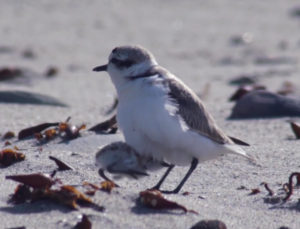NEWS
Ebb and Flow

Rare, Tiny Shorebirds Nests on Los Angeles County Beaches for First Time in Nearly 70 Years
FOR IMMEDIATE RELEASE – May 8, 2017
CONTACT
Ashley Spratt, 805-320-6225, Ashley_spratt@fws.gov
B-roll and photographs for media use available here: https://flic.kr/s/aHskUkNP3d
For the first time in nearly 70 years, western snowy plovers are nesting on Los Angeles County beaches.
The first nest was found on April 18 on Santa Monica State Beach, followed by discovery of a nest on Dockweiler State Beach on April 27, and two nests on Malibu Lagoon State Beach on April 28 and May 4. Following their discovery, U.S. Fish and Wildlife Service (Service) biologists installed small wire cages around each nest to protect the eggs from predators and human disturbance. The nests were discovered by monitors with Los Angeles Audubon and The Bay Foundation.
“This is a sign that, against all odds, western snowy plovers are making a comeback, and we really need the cooperation of beachgoers to help give them the space they need to nest and raise their young,” said senior fish and wildlife biologist Chris Dellith with the Service’s Ventura Fish and Wildlife Office. “I’m hopeful that we can find a balance between beach recreation and habitat restoration, which will allow humans and shorebirds like the western snowy plover to peacefully exist along our coastline.”
While the Santa Monica State Beach nest was lost as a result of high winds and one of the Malibu Lagoon State Beach nests was lost for unknown reasons, the remaining two nests remain viable.
Although western snowy plovers use beaches in Los Angeles County for roosting during the winter, the last documented active nest in the county was in 1949 at Manhattan Beach.
The Pacific coast population of western snowy plover inhabits the coastline from Baja California, Mexico, north to Washington. Plovers are about six inches long and weigh up to two ounces. Breeding and nesting season extends from March to September. They lay their eggs in small depressions in the sandy area of beaches with easy access to the water.
The Pacific coast population of western snowy plover was listed as a threatened species under the Endangered Species Act (ESA) in 1993, because of habitat loss, impacts from non-native predators, and other factors. At the time of listing, the California population was estimated to be about 1,300 adults. In 2016, the population was estimated to have increased to a little more than 1,800 adults.
Following the species listing under the ESA, numerous conservation partners have come together to support plover recovery, including restoring habitat and managing nesting areas to minimize disturbance to the birds.
In Los Angeles County, the plovers have benefited from a variety of conservation partners including California State Parks, California Department of Fish and Wildlife, The Bay Foundation, Los Angeles Audubon, Santa Monica Bay Audubon, the City of Santa Monica, the Los Angeles County Department of Beaches and Harbors, Cooper Ecological Monitoring, and Ryan Ecological Consulting.
The original Santa Monica State Beach nest was located in a 3-acre area that is being restored to a healthy coastal ecosystem by The Bay Foundation and City of Santa Monica to improve natural shoreline habitat.
The plover nests on Malibu and Dockweiler state beaches are located within partially fenced areas, but remain at risk of disturbance. To ensure the eggs and future chicks have the best possible change of survival, the Service asks beach goers to follow a few simple guidelines:
• Respect posted signage and fencing that identifies nesting areas.
• Keep your distance from western snowy plovers to avoid disturbing them. Adult plovers will sometimes use a broken wing display to distract predators away from chicks. If you observe what appears to be an injured adult or chicks lying on the ground, do not attempt to capture the adult or pick the chicks up. Back away and let the adults return to tend their chicks.
• When walking along the beach, stay on the wet hard-packed sand. The plovers use this area less than the upper part of the beach.
• As a reminder, dogs are not allowed on state beaches in Los Angeles County. Please adhere to local beach rules and regulations regarding dogs and always keep your dog on a leash to prevent nesting western snowy plovers from abandoning their nests.
• Take trash with you when you leave, or place in covered trash bins.
• To learn more about western snowy plovers, check out this short educational video, “The Snowy Plover and You.”
The mission of the U.S. Fish and Wildlife Service is working with others to conserve, protect, and enhance fish, wildlife, plants, and their habitats for the continuing benefit of the American people. We are both a leader and trusted partner in fish and wildlife conservation, known for our scientific excellence, stewardship of lands and natural resources, dedicated professionals, and commitment to public service. For more information on our work and the people who make it happen, visit http://www.fws.gov/ventura. Connect with our Facebook page, follow our tweets, watch our YouTube Channel and download photos from our Flickr page.
More MALIBU PLOVER NEWS>> HERE
